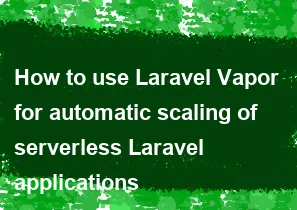How to use Laravel Vapor for automatic scaling of serverless Laravel applications

Laravel Vapor is a serverless deployment platform specifically designed for Laravel applications. It leverages AWS Lambda, AWS API Gateway, and other AWS services to provide automatic scaling for your Laravel applications.
Please note that the information provided here might be outdated, and it's crucial to refer to the official Laravel Vapor documentation for the most up-to-date information. The following steps provide a general overview of how you can use Laravel Vapor for automatic scaling:
1. Setup Laravel Vapor:
Install Vapor by running the following command in your Laravel project:
bashcomposer require laravel/vaporAfter installation, you need to set up your AWS credentials in the
~/.aws/credentialsfile or use environment variables.Run the Vapor installer:
bashphp artisan vapor:install
2. Configure Your Environment:
- Configure your environment settings in the
vapor.ymlfile. This file includes settings for environments, databases, queues, and more.
- Configure your environment settings in the
3. Deploy Your Application:
- Deploy your application to AWS by running:bash
vapor deploy
- Deploy your application to AWS by running:
4. Automatic Scaling:
Laravel Vapor leverages AWS Lambda, which is a serverless compute service. It automatically scales based on the number of requests, allowing your application to handle varying loads without manual intervention.
API Gateway is used to manage incoming HTTP requests. As the number of requests increases, AWS Lambda automatically scales up to handle the load.
Vapor also provides features like auto-scaling for your databases, queues, and more.
5. Monitoring and Logging:
Use AWS CloudWatch to monitor your serverless Laravel application. You can set up CloudWatch alarms to be notified of any issues or performance bottlenecks.
Laravel Vapor provides integrations with services like Papertrail for logging.
6. Customizing Scaling Settings:
- While Laravel Vapor provides automatic scaling, you may want to customize certain settings based on your application's requirements. Refer to the Vapor documentation for details on how to configure scaling settings, concurrency, and other options.
7. Testing and Optimization:
It's essential to test your application thoroughly to ensure it performs well under different loads.
Optimize your Laravel application for serverless architecture. Consider factors like cold starts, function duration, and resource consumption.
Always refer to the latest Laravel Vapor documentation for any updates or changes in the deployment process or configuration options. Keep in mind that the technology landscape evolves, and new features or improvements may have been introduced since my last update.
=== Happy Coding :)
-
Popular Post
- How to optimize for Google's About This Result feature for local businesses
- How to implement multi-language support in an Express.js application
- How to handle and optimize for changes in mobile search behavior
- How to handle CORS in a Node.js application
- How to use Vue.js with a UI framework (e.g., Vuetify, Element UI)
- How to configure Laravel Telescope for monitoring and profiling API requests
- How to create a command-line tool using the Commander.js library in Node.js
- How to implement code splitting in a React.js application
- How to use the AWS SDK for Node.js to interact with various AWS services
- How to use the Node.js Stream API for efficient data processing
- How to implement a cookie parser middleware in Node.js
- How to implement WebSockets for real-time communication in React
-
Latest Post
- How to implement a dynamic form with dynamic field styling based on user input in Next.js
- How to create a custom hook for handling user interactions with the browser's device motion in Next.js
- How to create a custom hook for handling user interactions with the browser's battery status in Next.js
- How to implement a dynamic form with dynamic field visibility based on user input in Next.js
- How to implement a dynamic form with real-time collaboration features in Next.js
- How to create a custom hook for handling user interactions with the browser's media devices in Next.js
- How to use the useSWRInfinite hook for paginating data with a custom loading indicator in Next.js
- How to create a custom hook for handling user interactions with the browser's network status in Next.js
- How to create a custom hook for handling user interactions with the browser's location in Next.js
- How to implement a dynamic form with multi-language support in Next.js
- How to create a custom hook for handling user interactions with the browser's ambient light sensor in Next.js
- How to use the useHover hook for creating interactive image zoom effects in Next.js